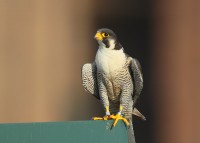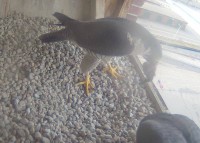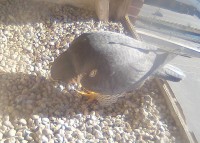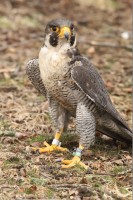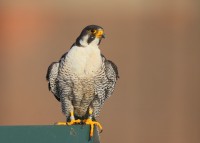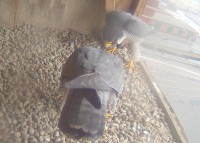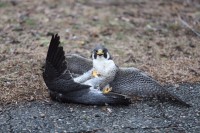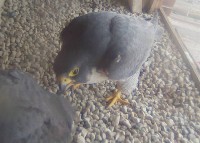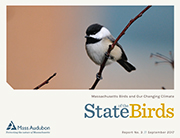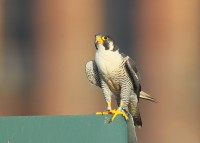 Here is a recap of the impressive legacy from Tom French:
Here is a recap of the impressive legacy from Tom French:
As a chick in 2001, the male Peregrine Falcon 6*/4* was one of four in the first urban Peregrine Falcon nest in New Hampshire (see attached news article). He was probably the banded juvenile plumaged male paired to an unbanded female that first occupied Lawrence, MA in 2002. They did not nest that year, but did the following year, and have been closely monitored ever since. Here is a summary:
His mates
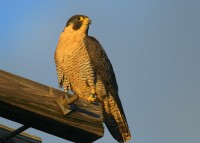 2003-2015 – V/5 (987-98049 black over green) banded as an adult at the Lawrence nest site when captured by hand.
2003-2015 – V/5 (987-98049 black over green) banded as an adult at the Lawrence nest site when captured by hand.
2015–present – An unbanded bird
Nest sites used by the Lawrence Peregrines – 3
2003-2004 – Ideal Box Company, Lawrence (current New Balance Shoe building) – S. of river – The pair nested in an abandoned Red-tailed Hawk nest built on a 6th floor window tray that once held a window-mounted air conditioning unit. That first year the hawk nest was removed and the chicks were placed in a nest box put on the air conditioner tray.
2005-2009 – Newark Atlantic paperboard warehouse, Lawrence – N. of river – The 2005-2006 nest site was in the 12 inch wide and 6 foot long space between the glass of a 4th floor window and a sheet of plywood covering the window on the inside of the building. The birds entered through a broken window pane and nested on old pigeon nest material and accumulated droppings. The window faced west on a 7 story old mill building. The 2007-2009 locatio0n was a similar site in another window on the same side of the building. A nest box was placed in the clock tower of the New Balance Shoe building in March 2008. In 2009, the chicks were moved from the window nest to a crudely constructed box on the roof of the same building.
2010 – New Balance Shoe Company clock tower (same building as Ideal Box Co.), 5 South Union Street
2011 – The pair moved back to the 2007-2009 window nest on the Newark Atlantic Paperboard Warehouse.
2012-present – The pair moved back to the New Balance Shoe Company clock tower.
Production
6*/4* nested for 15 seasons. The 2005 nest site was not discovered until the following year.
He helped fledge 42 chicks (21 male, 21 female) in 14 years (3.0 chicks/year), which is very high reproductive success.
All of the clutches of eggs at this site have been 4-egg clutches.
Reports of offspring after fledging:
Hatch year/sex
2003 female W/5, 0987-98050 – Became the resident female at the Traveler’s Tower in Hartford, CT 2007-2015. Struck the building while chasing a pigeon.
2004 male Y*/9, 2206-01254 – Found 9-15-05 in a cage in the back yard of a pigeon racer, still wearing bands. Had severe bumblefoot, euthanized
2009 female Y/55, 1807-76492 – South Beach, Chatham, MA 8-31-09; dead on a car grill Nantucket Isl., MA 1-5-10
2010 female 38/AE, 1807-76500 – Plum Isl., MA 8-16-10, remained through the fall and winter. Killed a White-faced Ibis (see You Tube) https://www.youtube.com/watch?v=eyqijh2sMao
2010 male 14/X, 2206-81828 – Plum Isl., MA 11-7-10, 1-15-11, 10-22-11, 11-4-11, 11-11-11. Became the resident male at Fox Hall, UMass, Lowell, MA 6-18-14 to 7-7-14 when found grounded from
fight; treated and released at Tufts, Grafton, MA 9-30-14 and resumed his place at the UMass, Lowell nest; lost an eye from a shotgun pellet 1-8-16; disappeared from nest site on 3-29-16 after a fight; found grounded and emaciated at Governor’s Academy, Newbury, MA 4-8-16; died at Tufts Wildlife Clinic 4-11-16.
2011 female 24/AE, 1947-02310 – Plum Isl., MA 9-17-11, 9-30-11.
2012 female 31/AE, 1947-02317 – Seen for several days at West Rock State Park peregrine nest, Hamden, New Haven Co., CT.
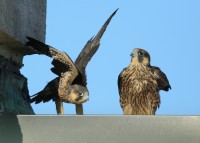 2013 female 93/AD, 1947-02334 – Fractured metacarpal near nest 20 days after fledging 6-29-13; treated and later released.
2013 female 93/AD, 1947-02334 – Fractured metacarpal near nest 20 days after fledging 6-29-13; treated and later released.
2013 male 11/BD, 2206-81887 – Nashua, NH 3-23-15. Nested on the I-293/Rte. 101 bridge over the Merrimack River, Manchester, NH 2016-2017
2013 male 12/BD, 2206-81888 – Became the resident male at Boston University, Boston, MA 2015-present.
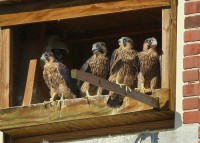 2016 male 85/BS, 1156-19151 – Injured by a plane at Logan Airport, Boston, and euthanized 8-31-16.
2016 male 85/BS, 1156-19151 – Injured by a plane at Logan Airport, Boston, and euthanized 8-31-16.
Eleven of 42 fledged chicks (26%) were reported after fledging, including 5 males & 6 females.
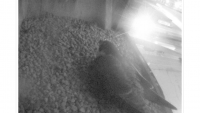 Here we are at minutes before 6AM, with sunrise at about 6:16AM, and looking in on the female. It sure looks like she is hunkered down tight on her fist egg. But, not yet able to confirm until she lifts up, and provides a look! She is seen here in typical incubation posture, providing every indication that the first egg has been laid.
Here we are at minutes before 6AM, with sunrise at about 6:16AM, and looking in on the female. It sure looks like she is hunkered down tight on her fist egg. But, not yet able to confirm until she lifts up, and provides a look! She is seen here in typical incubation posture, providing every indication that the first egg has been laid.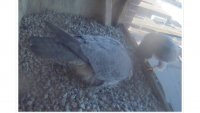 A few minutes before 8AM, the male returns to the nest box with prey in bill and offers it to the female who has maintained her incubation posture. As she receives th eprey, she does little to help confirm that the first egg has been laid!
A few minutes before 8AM, the male returns to the nest box with prey in bill and offers it to the female who has maintained her incubation posture. As she receives th eprey, she does little to help confirm that the first egg has been laid!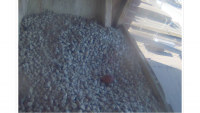 Finally after waiting and waiting, the female laid her first egg early this morning well before sunrise. Her behavior was very consistent with the general lethargy that a female falcon typically experiences in the few days prior to laying the first egg. In many cases this lethargy may last a week or longer. She lazes around and spends lots of time in the nest box, nest scraping, and other courtship related activities.
Finally after waiting and waiting, the female laid her first egg early this morning well before sunrise. Her behavior was very consistent with the general lethargy that a female falcon typically experiences in the few days prior to laying the first egg. In many cases this lethargy may last a week or longer. She lazes around and spends lots of time in the nest box, nest scraping, and other courtship related activities.



